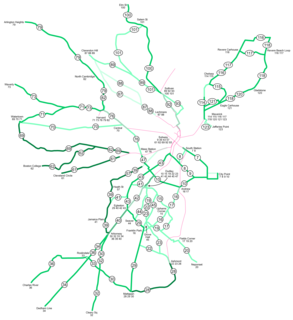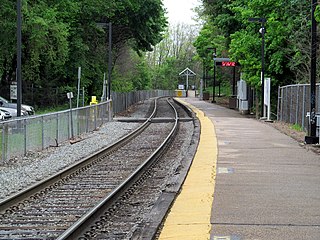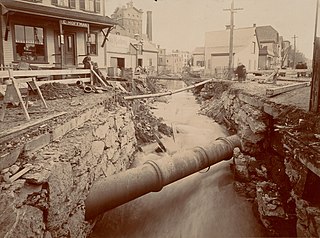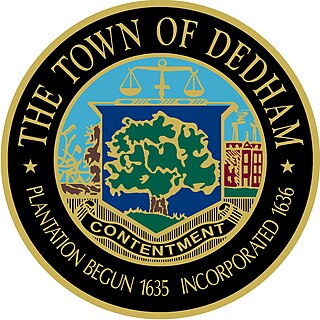
The Forest Hills disaster (also called the Forest Ridge disaster and the Bussey Bridge train disaster) was a railroad bridge accident that occurred on March 14, 1887, in the Roslindale section of Boston, Massachusetts.

The Forest Hills disaster (also called the Forest Ridge disaster and the Bussey Bridge train disaster) was a railroad bridge accident that occurred on March 14, 1887, in the Roslindale section of Boston, Massachusetts.
A morning commuter train, inbound to Boston, was passing over the Bussey Bridge, a Howe truss, at South Street in the Roslindale neighborhood a half mile from the Forest Hills station, when it suddenly collapsed, sending several cars crashing to the street below. Thirty-eight commuters were killed and another 40 were seriously injured. [1] [2]

The train, made up of nine cars, was traveling over the Dedham Branch of the Boston & Providence Railroad on a sunny Monday morning with about 300 passengers, including several school children. Six miles from Boston, the train crossed over the Bussey Bridge on its approach to the Forest Hills Station. The locomotive and first two cars crossed the bridge and then suddenly, without any warning, the bridge fell, taking the third, fourth, fifth, and sixth cars with it. The shock of the collapse was so quick and forceful that the body of one of the cars fell and its roof tore off completely and landed on the embankment beyond the bridge. [2]
The disaster shocked the entire nation, especially the suffering of the injured, some of whom were transfixed by splinters throughout their bodies and others dismembered and yet others badly mangled. The first body that rescuers pulled from the wreck was that of a headless woman. Two young men were pinned under a pile of rubble with a car stove full of glowing coals hanging over them. Fortunately, the doors of the stove stayed closed and the bolts held firmly and they were rescued. [3]
An investigation found that the iron bridge design was poor; it was not strong enough to carry the load of traffic it had to serve. Its designer, Edmund Hewins, was exposed as a fraud. Investigators found that the railroad had also failed to inspect and properly maintain the bridge, even though nuts and bolts were discovered which had fallen from the bridge and were lying on the street below. [2] [4]
| Wikimedia Commons has media related to Bussey Bridge . |

Roslindale is a primarily residential neighborhood of Boston, Massachusetts, bordered by Jamaica Plain, Hyde Park, West Roxbury and Mattapan. It is served by an MBTA Commuter Rail line, several MBTA bus lines and the MBTA Orange Line in nearby Jamaica Plain. Roslindale has its own branch of the Boston Public Library, the neighborhood is covered by Boston Police District E-5 in West Roxbury, Boston EMS Ambulance 17 is stationed in Roslindale, and the Boston Fire Department has a station on Canterbury Street which houses Ladder 16, Engine 53 & District Chief 12. Roslindale's original Engine Company 45, was deactivated on April 10, 1981, due to budget cuts. Roslindale was once called the "garden suburb" of Boston. The portion of the Arnold Arboretum south of Bussey Street is located in Roslindale.

The Ashtabula River railroad disaster was the failure of a bridge over the Ashtabula River near the town of Ashtabula, Ohio, in the United States on December 29, 1876. A Lake Shore and Michigan Southern Railway train, the Pacific Express, passed over the bridge as it failed. All but the lead locomotive plunged into the river. The train's oil lanterns and coal-fired heating stoves set the wooden cars alight. Firefighters declined to extinguish the flames, leaving individuals to try to pull survivors from the wreck. Many who survived the crash burned to death in the wreckage. The accident killed approximately 92 of the 160 people aboard. It was the worst rail accident in the U.S. in the 19th century and the worst rail accident in U.S. history until the Great Train Wreck of 1918.
The Southwest Corridor or Southwest Expressway was a project designed to bring an eight-lane highway into the City of Boston from a direction southwesterly of downtown. It was supposed to connect with Interstate 95 (I-95) at Route 128. As originally designed, it would have followed the right of way of the former Penn Central/New Haven Railroad mainline running from Readville, north through Roslindale, Forest Hills and Jamaica Plain, where it would have met the also-cancelled I-695. The 50-foot-wide median for the uncompleted "Southwest Expressway" would have carried the southwest stretch of the MBTA Orange Line within it, replacing the Washington Street Elevated railway's 1901/1909-built elevated railbed. Another highway, the four-lane South End Bypass, was proposed to run along the railroad corridor between I-695 in Roxbury and I-90 near Back Bay.
The Great East Thompson Train Wreck was a large rail disaster which occurred in East Thompson, Connecticut, on December 4, 1891. It was one of the most extensive train wrecks in American history, and the first of two to involve four trains. It happened on the New York and New England Railroad, which provided a shortcut from New York City to Boston by making a diagonal across Connecticut. The railroad is now abandoned, and most of its tracks removed.

Forest Hills station is an intermodal transfer station in Boston, Massachusetts. It serves the MBTA rapid transit Orange Line and MBTA Commuter Rail Needham Line, and is a major terminus for MBTA bus routes. It is located in Forest Hills, in the southern part of the Jamaica Plain neighborhood. Most Providence/Stoughton Line trains, and all Franklin Line and Amtrak Northeast Corridor trains, pass through the station without stopping.

As with many large cities, a large number of Boston-area streetcar lines once existed. However, only a few remain, namely the four branches of the Green Line and the Ashmont–Mattapan High-Speed Line, with only one running regular service on an undivided street.

The Boston and Providence Railroad was a railroad company in the states of Massachusetts and Rhode Island which connected its namesake cities. It opened in two sections in 1834 and 1835 - one of the first rail lines in the United States - with a more direct route into Providence built in 1847. Branches were built to Dedham in 1834, Stoughton in 1845, and North Attleboro in 1871. It was acquired by the Old Colony Railroad in 1888, which in turn was leased by the New Haven Railroad in 1893. The line became the New Haven's primary mainline to Boston; it was realigned in Boston in 1899 during the construction of South Station, and in Pawtucket and Central Falls in 1916 for grade crossing elimination.

Readville is part of the Hyde Park neighborhood of Boston. Readville's ZIP Code is 02136. It was called Dedham Low Plains from 1655 until it was renamed after the mill owner James Read in 1847. It was part of Dedham until 1867. It is served by Readville station on the MBTA Commuter Rail. It is on the original alignment of Route 128, later part of a since-discontinued section of Route 135. Readville is bordered by the Town of Milton to the south and the Town of Dedham to the west. Paul's Bridge, which is at the neighborhood's entrance as one approaches Milton, is one of the oldest bridges in the Commonwealth. The name comes from James Read, a resident and cotton mill owner. Readville is covered by Boston Police Department District E-18 in Hyde Park and a fire station on Neponset Valley Parkway houses Boston Engine Company 49. Readville is also home to several light industries.

The Needham Line is a branch of the MBTA Commuter Rail system, running west from downtown Boston, Massachusetts through Roxbury, Jamaica Plain, Roslindale, West Roxbury, and the town of Needham. The second-shortest line of the system at just 13.7 miles long, it carries 8,218 daily riders. Unlike the MBTA's eleven other commuter rail lines, the Needham Line is not a former intercity mainline; instead, it is composed of a former branch line, a short segment of one intercity line, and a 1906-built connector.

The Great Chatsworth train wreck was a major rail accident that occurred late on the night of August 10, 1887, 3 miles (5 km) east of Chatsworth, Illinois, in the United States. A Toledo, Peoria and Western Railroad (TP&W) train bound for Niagara Falls crossed over a trestle, weakened earlier in the day by a fire, causing it to collapse. In 2007, staff of the McLean County Museum of History wrote that "the Chatsworth Train Wreck probably ranks as the second- or third-deadliest U.S rail accident in the 19th century."

Roslindale Village station is an MBTA Commuter Rail station on the Needham Line, located in the Roslindale Square business district of the Roslindale neighborhood in Boston, Massachusetts. The station has a single side platform serving the line's single track, with a mini-high platform for accessibility.

West Roxbury is an MBTA Commuter Rail station in Boston, Massachusetts. It serves the Needham Line. It is located on an embankment above Lagrange Street in the West Roxbury neighborhood. The station is accessible with a short mini-high platform on the outbound end of the main platform.

The Naperville train disaster occurred April 25, 1946, on the Chicago, Burlington and Quincy Railroad at Loomis Street in Naperville, Illinois, when the railroad's Exposition Flyer rammed into the Advance Flyer, which had made an unscheduled stop to check its running gear. The Exposition Flyer had been coming through on the same track at 80 miles per hour (130 km/h). There were 45 deaths and some 125 injuries. This crash is a major reason why most passenger trains in the United States have a speed limit of 79 mph (127 km/h).

The Angola Horror train wreck occurred on December 18, 1867, just after 3 p.m. when the last coach of the Buffalo-bound New York Express of the Lake Shore Railway derailed at a bridge, slid down into a gorge and caught fire in Angola, New York, United States, killing approximately 49 people. At the time, it was one of the deadliest train wrecks in American history.

Stony Brook is a 8.5-mile (13.7 km)-long subterranean river in Boston. The largest tributary stream of the lower Charles River, it runs mostly through conduits. Stony Brook originates at Turtle Pond in the Stony Brook Reservation and flows through Hyde Park, Roslindale, Jamaica Plain, and Roxbury. It empties into the Charles River Basin just upstream of the Harvard Bridge. Stony Brook is fed by four tributaries, all of which are partially or entirely in conduits as well.

Mount Hope station was a railroad station on the Northeast Corridor in Roslindale, Boston, Massachusetts. The station consisted of two separate depots on opposite sides of the tracks. The brick outbound depot was located just north of the Blakemore Street bridge, while the wooden inbound depot was located south of the overpass.

The history of rail in Dedham, Massachusetts begins with the introduction of the first rail line in 1836 and runs to the present day. Multiple railroads have serviced Dedham since then, and current service is provided by the MBTA. The station in Dedham Square built in 1881 out of Dedham Granite was demolished in 1951 and the stones were used to put an addition on the Town's library. There are two active stations today, and multiple others in close proximity.
The Chester train wreck occurred on August 31, 1893, outside of Chester, Massachusetts. A bridge collapse plunged four train cars into the Westfield River, killing 14 people. An investigation by Massachusetts Railroad Commission found that the bridge had been weakened by a maintenance crew that had removed rivets from the bridge.